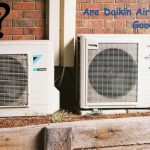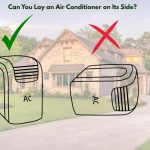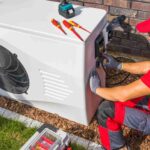When the summer sun decides to turn up the heat, many of us start dreaming of cool, refreshing air. For decades, the trusty window AC unit has been our go-to solution, a literal breath of fresh air in sweltering times. But what happens when your living space throws a curveball, presenting you with windows that don’t quite play by the conventional rules? That’s where the burning question comes in: can window air conditioners be installed vertically?
We’re here to tell you that, for many, the answer is a resounding “Yes.”
How to Size Your AC for Vertical Installation?
Sizing your window AC unit for a vertical window is key for efficient cooling. We ensure it fits, not just physically, but perfectly for your space.
Measure Your Space
First, grab your tape measure. Accurately measure your room’s length and width to calculate square footage. This precise measurement is your starting point.
Consult a BTU Chart
Next, use a BTU chart as a guide (e.g., 5,000-6,000 BTUs for 150-250 sq ft). Factor in variables like sun exposure or insulation; hot rooms need more BTUs. Be a savvy detective.
Measure Your Window Opening
Crucially, meticulously measure your window opening. Note the precise vertical space and width. Remember, casement air conditioners are designed for these narrow window gaps. A perfect physical fit, including side fillers, is absolutely essential.
Read about: Expert’s Guide to Reset Midea Air Conditioner Remote Control
Pre-Installation Preparations To Install AC Vertically:

Before you even think about lifting that window AC unit, a little preparation goes a long way. Think of it like cooking a gourmet meal; you wouldn’t just start chopping vegetables willy-nilly. A well-prepared workspace and a careful assessment of your window will save you headaches, heartaches, and potentially even trips to the hardware store!
Checking Window Suitability
Not all windows are suited for a vertical window AC! We ensure your window opening is structurally sound and safe for installation.
Assess Your Window Type
First, know your window. Double-hung windows are usually best for vertical AC installation, especially with a casement air conditioner. Horizontal sliders or crank-outs are far trickier and often require professional help.
Measure the Opening Accurately
Next, grab your tape measure. Precisely get the vertical space and width of your window opening. This isn’t a casual estimate; a snug, stress-free fit for your window AC unit and its panels is vital.
Inspect the Window Frame
Thoroughly check your window frame. Look for rot, cracks, or damage. A weak frame won’t safely support the window AC unit, posing hazards. Think of it as your foundation – it must be solid!
Check for Obstructions
Also, ensure no blinds, curtains, or window locks will interfere. You need clear space for the window AC unit and proper window function. Don’t let anything block its path.
Consider the Exterior
Finally, peek outside. Clear any trees or awnings that could block airflow to the AC unit’s coils. Also, plan for condensation draining; you don’t want drips creating hazards below.
You got it! Here’s the “How to Clean and Reinforce the Window Frame?” section, condensed, with an H3 for each paragraph, while strictly following all previous commands:
How to Clean and Reinforce the Window Frame?
Once your window is confirmed suitable, it’s time to prep it. A clean, reinforced window frame provides a stable, secure home for your new AC, ensuring both safety and optimal performance.
Thorough Cleaning
First, give your window frame a good scrub. Remove all dirt, grime, and old paint flakes. A clean surface helps sealing materials stick properly, preventing air leaks. Think of it as prepping a canvas for a masterpiece.
Inspect for Damage
Next, meticulously inspect the window frame for any rot, splintering, or loose sections. Pay special attention to the window sill, as it often suffers weather exposure. Even minor imperfections can compromise structural integrity.
Make Necessary Repairs
If you find any damage, address it immediately. This might mean patching holes, reinforcing loose joints with screws, or replacing rotten wood. Don’t cut corners; a strong foundation is everything for your window AC unit.
Reinforce the Sill (If Needed)
Since the window sill bears significant weight, consider adding extra support, especially for heavier units or older windows. A sturdy piece of lumber secured underneath can provide a robust platform. It’s like giving your window a strong backbone.
Ensure Level Surface
Finally, use a level to ensure your window sill and frame are perfectly level. An unlevel installation can cause uneven cooling, increased noise, and improper condensation draining. A little tilt can become a big problem, so make sure everything is plumb and true.
Why Gathering Necessary Tools and Materials?
A craftsman’s only as good as their tools! For installing a window AC unit vertically, having everything ready ensures a smoother, safer, and less frustrating process. No one likes hunting for a screw mid-job!
Essential Tools & Materials List
Here’s what we recommend gathering for your vertical AC journey:
- Your chosen window air conditioner (vertical-compatible)
- Safety gear (gloves, safety glasses)
- Tape measure & pencil
- Drill & bits
- Screws & fasteners
- Screwdrivers
- Level (crucial for condensation draining)
- Weatherstripping & foam insulation (for your window frame)
- Caulking gun & caulk
- Utility knife/scissors
- Wood shims
- Support brackets (if needed)
- Shop vacuum or broom
- User manual (your installation bible!)
Follow these Steps for Vertical Installation
Alright, the moment of truth has arrived! With your window prepped and your tools at the ready, it’s time to tackle the actual installation. This is where precision and patience truly pay off. Remember, we’re not just throwing something into a hole; we’re creating a secure, efficient cooling system for your home.
Clearing the Installation Area
Before we even touch the AC unit, we need to ensure the space is clear and safe. This isn’t just about convenience; it’s about preventing accidents and allowing for smooth movement during what can be a somewhat awkward process.
Here are the steps we recommend for clearing your installation area:
Remove Obstacles:
First things first, clear out any furniture, decorative items, or anything else that might be in the way of the window opening or the immediate surrounding area. You’ll need ample room to maneuver the window AC unit and yourself. Think of it like preparing a stage before the show begins.
Clear the Window Sill:
Make sure the window sill itself is completely free of clutter, dust, or debris. This will be the resting place for your AC unit, and you want it to be as clean and stable as possible.
Protect the Floor:
If you’re working on carpet or a delicate floor, lay down a drop cloth or old blankets. Accidents happen, and a little foresight can save you from a big clean-up or costly repairs.
Ensure Good Lighting:
You’ll need to see what you’re doing clearly, especially when dealing with measurements and small fasteners. If natural light isn’t sufficient, bring in a work lamp. Don’t be left in the dark, literally!
Designate a Tool Zone:
Set up a small, organized area nearby where you can easily access all your tools and materials. This prevents frantic searching and keeps everything within arm’s reach. A little organization goes a long way in keeping your sanity.
Read More: Step by Step Guide to Reset Filter on LG Air Conditioner
How to Mount the AC Unit Vertically?
This is often the trickiest part, as window AC units can be heavy and awkward. We always recommend having a second person assist you if possible, especially with larger units. Safety is key; don’t be a hero and try to lift more than you can handle.
Here are the steps for mounting your window AC unit vertically:
- Careful Lifting: With help, carefully lift the window AC unit, making sure you have a firm grip. Remember to lift with your legs, not your back!
- Align with Brackets: Gently slide the unit into the window opening, aligning it with the secured brackets. Many units have grooves or slots that will fit directly onto the brackets. It should feel like it’s settling into place, not forcing.
- Secure the Unit to Brackets: Once the unit is in place, you’ll typically need to secure it further to the brackets. This might involve tightening screws or engaging latches that lock the unit onto the brackets. Again, refer to your manual for the exact mechanism.
- Extend Side Panels: For most casement air conditioners or units designed for vertical installation, there will be accordion-style side panels that extend to fill the remaining gap between the window AC unit and the sides of the window frame. Gently pull these out until they meet the frame.
- Final Adjustments and Leveling: Use your level one last time to ensure the unit is perfectly level both horizontally and vertically. Small adjustments can be made by slightly repositioning the unit within the brackets or using shims if necessary. This step is critical for efficient operation and proper condensation draining.
To know more about condensation draining, check it-
Read about: Steps to Reset GE Air Conditioner Filter
Safety Measures
When it comes to installing an AC unit, safety should always be your co-pilot. Cutting corners here is simply not an option. We’re talking about heavy machinery, electricity, and the structural integrity of your home. A little vigilance goes a long way in preventing unfortunate incidents.
How to Fix Common Issues to Installing a Vertical AC?
Even with the best preventive care, sometimes your AC unit will throw a curveball. Knowing how to diagnose and potentially fix common issues can save you a service call and get you back to cool comfort quickly.
Unit Not Cooling/Weak Airflow:
Fix: Dirty filter is the prime suspect. Clean or replace it. Also, check for anything blocking the intake or exhaust vents. Ensure the temperature setting is low enough and the unit is on “Cool” mode.
Water Leaking (Inside or Outside):
Fix: Most often due to improper tilt (for vertical installations, check that it’s tilted slightly outwards for condensation draining), or a clogged drain pan/hose. Clear any blockages. If coils are frozen, turn off the unit to defrost.
Unusual Noises (Rattling, Buzzing):
Fix: Check for loose screws on the casing or mounting brackets. Ensure the unit is sitting securely in the window opening and not vibrating against the window frame. Sometimes, debris (like a leaf) can get into the fan. If the noise is grinding or squealing, it could be a fan motor issue requiring professional attention.
Unit Cycles On and Off Too Frequently (Short Cycling):
Fix: If the unit is too large for the room, it will short cycle. If the filter is very dirty, it can also cause this. Ensure the thermostat sensor isn’t in direct sunlight. If it’s a constant issue, consider getting a professional to assess if the unit is properly sized.
Unit Smells Musty/Moldy:
Fix: This is usually due to mold or mildew growth in the drain pan or on the coils due to stagnant water. Clean the drain pan thoroughly and use a coil cleaner. Ensure proper condensation draining.
Conclusion
So, there you have it! We’ve navigated the world of vertically installed window air conditioners, from “Can window air conditioners be installed vertically?” to installation, maintenance, and environmental impact. We’ve shown you this isn’t just possible, but often the smartest, most efficient, and most aesthetically pleasing way to cool challenging spaces.
Ready to make the switch? Roll up your sleeves, use this guide, and confidently transform your window into a source of refreshing relief. The cool, crisp air is waiting for you!
FAQ: Your Burning Questions Answered
Not every window is ideal. While some window AC units, especially casement air conditioners, suit double-hung windows for vertical placement, horizontal sliders or crank-outs usually aren’t compatible. It truly depends on your specific window opening.
Absolutely! Many vertical window AC units, including casement air conditioners, are Energy Star certified. Always look for this label; it guarantees strict energy efficiency, leading to lower bills and a smaller environmental footprint.
It varies. Check your local municipality and HOA rules. Standard window AC unit installations often don’t need a permit, but significant structural modifications to your window frame, new electrical wiring, or excessive unit protrusion might require one. Always verify beforehand to avoid issues.
Proper condensation draining is crucial for your window AC unit. First, ensure the unit tilts slightly outwards. Check the drain pan and hole for clogs and clear any debris. If coils are frozen, defrost the unit. For persistent issues like a faulty pump or complex clogs, call an HVAC professional.
Yes! The best eco-friendly choice is a highly energy-efficient model with a high EER/SEER rating, ideally Energy Star certified. Proper installation and regular maintenance ensure your vertical AC units run efficiently. Also, always recycle your old unit responsibly.









